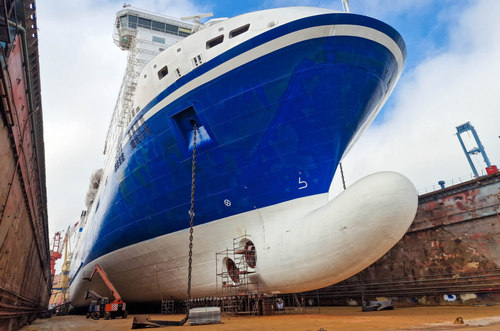MONDAY, MAY 13, 2024
Shipping operator Finnlines recently adopted the use of sustainable coatings company GIT Coatings’ graphene-based hard foul release hull coating to accelerate its decarbonization efforts across the company’s fleets.
According to GIT, Finnlines has already applied the XGIT-Fuel coating to four vessels as part of its recently signed fleet agreement, cutting back on fuel consumption and emissions by around 7% compared to previously used coatings.
About the Project
For the past 10 years, Finnlines has reportedly worked to invest in its sustainability initiatives to enhance vessel performance and reduce carbon emissions. These investments include the introduction of new, efficient vessels and the upgrading of existing ones with energy-saving technologies.
One of their most recent projects includes the application of the low-friction hull coating XGIT-Fuel across its fleet, which helps reduce fuel consumption and emissions by cutting down vessel drag.
“Our commitment to sustainability is at the forefront of every decision we make. By integrating XGIT-Fuel into our fleet, we are not only reducing costs and advancing our environmental goals but also setting a new standard in the industry for environmental responsibility,” said Thomas Doepel, VP and Deputy CEO at Finnlines.

 |
| GIT Coatings |
|
Shipping operator Finnlines recently adopted the use of sustainable coatings company GIT Coatings’ graphene-based hard foul release hull coating to accelerate its decarbonization efforts across the company’s fleets. |
On top of reducing vessel drag, XGIT-Fuel reportedly utilizes graphene to improve resistance to mechanical damage, making it more suitable for vessels sailing in icy conditions. Additionally, it can be cleaned without affecting the surface of the coating.
XGIT-Fuel has a temperature range from -5 to 40 degrees Celsius, helping to expand the application period and enable Finnlines to improve the performance of vessels scheduled for winter drydocking.
“Finnlines has been a great partner for us in many ways, and their openness to sharing data from their vessels has given us the opportunity to further validate the benefits of the coating,” said Maiko Arras, the Director of Business Development at GIT.
“It has become clear that Finnlines has reduced fuel consumption and carbon emissions by around 7% compared to the previous coatings on the vessels whose hulls have been coated with XGIT-FUEL.”
The XGIT-Fuel coating reportedly aligns with Finnlines’ goal of improving operational efficiency and sustainability under tighter regulatory conditions.
The company reportedly has plans to continue its partnership with GIT Coatings in the coming years, expanding the use of XGIT-Fuel to additional vessels within its fleet.
Other GIT Projects
At the beginning of April, global shipping company Pacific Basin recently announced that it would be applying a sustainable, graphene-based propeller coating from GIT across its entire fleet.
The new decarbonization initiative would reportedly be the largest adoption of graphene-based propeller coatings in the dry bulk segment, showcasing Pacific Basin’s commitment to sustainability.
XGIT-Prop, developed by GIT, reportedly has the potential to improve vessel performance by up to 4%, also making it a highly effective solution to improve Carbon Intensity Indicator (CII) and RightShip Greenhouse Gas ratings.
After a successful application process, followed by observing positive results on one of its Supramax dry bulk vessels, Pacific Basin decided to use XGIT-Prop across 40 vessels scheduled for dry dock maintenance in 2024.
The new deal was meant to parallel efforts of industry counterparts like Stolt Tankers and Eastern Pacific Shipping, amongst many others.
XGIT-Prop is a biocide-free hard foul release coating, built to work in harsh conditions faced by propellers. The coating reportedly combines an adhesive primer with a hard foul release topcoat to keep the propeller's surface smooth over the drydocking cycle.
In a fuel efficiency study conducted by Stolt Tankers in 2022, it was shown that XGIT-Prop has the potential to reduce fuel consumption by up to 4%. The fleet agreement between Pacific Basin and GIT Coatings is meant to highlight the shipping industry's shift towards sustainability.
A week later, Brazilian technology development company WEG reportedly also signed an agreement with GIT Coatings to help strengthen one another’s marine coating product offerings.
According to a release from WEG, the partnership was to build on plans to increase marine shipping efficiency at reduced costs while reaffirming both companies’ commitment to sustainability.
WEG stated that, with the new agreement, both companies would utilize each other’s strengths and knowledge to improve product offerings and provide custom solutions to customers.
The collaboration was meant to signify GIT’s growth as a sustainable graphene-based solutions provider working with ship owners to reduce their fuel costs and reduce the carbon footprint.
Focused on offering integrated solutions, this partnership was expected to align with WEG’s goal of finding innovative solutions with low environmental impacts.
The new partnership, WEG said, could potentially help boost the market adoption of green solutions in the marine market, such as GIT’s graphene-based coatings. Both WEG and GIT stated that they hope this collaboration will help strengthen their offerings across global markets.
Tagged categories: Antifoulants; Business management; Business matters; Business operations; Coating Application; Coating Materials; Coating Materials; Coatings; Coatings technology; Coatings Technology; Environmental Controls; Environmental Protection; Foul release; GIT Coatings; Green coatings; Marine; Marine Coatings; Program/Project Management; Protective coatings; Ships and vessels; Specialty functions; Sustainability